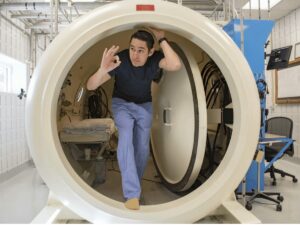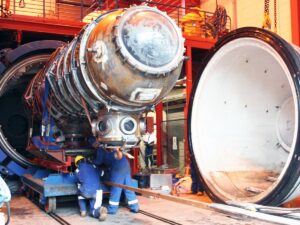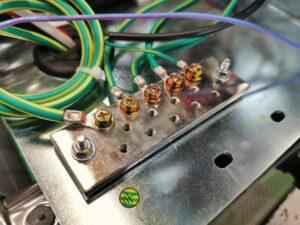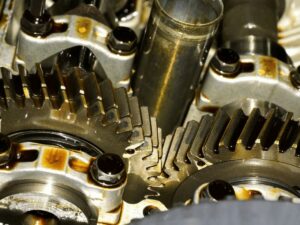Are you leveraging the full potential of your inflatable hyperbaric chamber to drive success in your medical or wellness business? Securing the longevity of your chamber is essential for maximizing its benefits.
As a seasoned expert in hyperbaric technology, my guidance is shaped by hands-on expertise, making me a trusted source for maintaining these sophisticated systems.
Here is a sneak peek of the 2 standout tips for maintaining your chamber:
- Daily Visual Inspections
- Regular Cleaning
In this guide, you’ll gain insights into keeping your inflatable hyperbaric chamber in top shape, by exploring the top 10 tips that can extend the life of your equipment and safeguard your investment.
Read on to maintain your chamber at its best!
1. Daily Visual Inspections
Regularly examining the inflatable hyperbaric chamber is crucial for identifying any early signs of wear and tear or potential issues. These checks help prevent small problems from becoming larger, more costly ones. Let’s explore below how to conduct daily visual inspections in the chamber:
- Surface Check: Look for any signs of external damage, such as cracks, abrasions, or unusual wear patterns on the surface of the chamber. This can indicate areas of stress or potential breaches in the chamber’s integrity.
- Seal Integrity: I always stress the importance of examining the seals and zippers to guarantee they are free from debris and damage. Proper sealing is essential for maintaining the chamber’s pressure and preventing leaks.
- Interior Condition: Inspect the inside of the chamber for any loose threads or punctures. Here’s the interesting part, the interior should be clean and intact to guarantee safe and comfortable use for patients or clients.
- Connector and Hose Health: Check all connectors and hoses for signs of wear, ensuring they are secure and undamaged. These components are vital for the safe transfer of air and oxygen into the chamber.

2. Regular Cleaning
Consistent and thorough cleaning of the inflatable hyperbaric chamber plays an essential role in its maintenance and operational lifespan. It prevents the buildup of harmful substances that could degrade the chamber’s materials and compromise safety. Here are the crucial parts of the chamber that require regular attention:
- Chamber Exterior: The outside surface of the chamber should be cleaned regularly to remove dirt, dust, and any other particles that could adhere to it. Keeping the exterior clean also helps to inspect the chamber for damages more easily.
- Interior Surfaces: The interior of the chamber, where users spend their time, must be kept clean to guarantee a safe and comfortable environment. Regular cleaning helps prevent the growth of mold and mildew, which can be harmful to the chamber and its occupants.
- Seals and Zippers: Seals and zippers are critical for maintaining the chamber’s pressurization. They should be cleaned carefully to remove any debris that could prevent a tight seal. This ensures the chamber functions correctly, an upkeep I carefully follow.
- Control Panels: The control panels and any touchscreens need regular wiping to remove fingerprints and contaminants. This helps to keep the chamber looking professional and prevents the buildup of substances that could interfere with functionality.
3. Check Air Quality and Filtration
Maintaining excellent air quality and efficient filtration within the hyperbaric chamber is essential for safety and performance. This certifies a clean, breathable environment for users and protects the chamber’s internal systems. Here’s a simple way to check air quality and filtration:
- Filter Replacement: I adhere to the guideline of regularly replacing or cleaning the air filters according to the manufacturer’s instructions. This keeps the air free of contaminants and maintains optimal airflow within the chamber.
- Monitor Humidity: Keep an eye on humidity levels inside the chamber, as excessive moisture can affect air quality and lead to mold growth. Use dehumidifiers if necessary to maintain a balanced environment.
- Air Purity Tests: Conduct regular air purity tests to detect any harmful gases or pollutants. So what’s my point? These tests guarantee the health and safety of the chamber’s users and staff.
- Filtration System Inspection: Inspect the chamber’s filtration system for any signs of wear or damage. A fully functional filtration system is key to providing clean air and preventing contaminants from entering the chamber.

4. Monitor Oxygen Levels
Ensuring the correct oxygen levels within the hyperbaric chamber is crucial for both the safety of its users and the chamber’s operational efficiency. Accurate monitoring helps prevent hypoxic or hyperoxic conditions, which can be harmful. Here are the essential practices for monitoring oxygen levels:
- Regular Calibration Checks: Calibration of oxygen sensors should be conducted at intervals recommended by the manufacturer. It allows sensors to provide accurate readings, essential for maintaining a safe therapeutic environment.
- Sensor Replacement Plans: Oxygen sensors have a finite lifespan and their sensitivity diminishes over time. Establishing a schedule for replacing these sensors guarantees consistent operation, safeguarding patients and equipment.
- Environmental Control: Controlling the environment around the hyperbaric chamber can affect oxygen level readings. Keeping the area well-ventilated and free from potential contaminants is key for the accuracy of oxygen measurements, a measure I constantly apply.
- Emergency Protocols: Have emergency protocols in place for handling situations where oxygen levels become dangerously high or low. For example, having staff trained in emergency responses and ensuring all safety equipment is easily accessible.

5. Pressure Testing
Conducting pressure testing on the hyperbaric chamber is a critical maintenance activity to secure its safe operation and durability. This process involves evaluating the chamber’s ability to maintain pressure over time without leaks. Here’s how to carry out effective pressure testing:
- Initial Preparation: Before beginning the test, make sure the chamber is clean and clear of any objects that could interfere with the process. This preparation step is crucial for obtaining accurate results.
- Seal Inspection: Carefully inspect all seals and closures to confirm they are properly secured and free of damage. This is essential to prevent air from escaping during the test.
- Gradual Pressurization: Slowly increase the chamber’s pressure to the recommended testing level, monitoring for any signs of stress or failure. This gradual approach helps protect the chamber from damage.
- Monitoring Phase: Once the desired pressure is reached, maintain it for a set period to observe the chamber’s performance. Looking for any pressure drop that could indicate a leak is a vigilance I maintain throughout the process.

6. Check and Calibrate Gauges
Regularly checking and calibrating the gauges of the hyperbaric chamber is essential to guarantee accurate measurements of pressure and oxygen levels. This accuracy is vital for the safety and effectiveness of the chamber’s treatments. Here’s how to maintain the gauges:
- Visual Inspection: Start with a visual inspection of each gauge for signs of damage or wear. For example, checking for cracks or irregularities in the gauge face might affect readability and accuracy.
- Calibration Frequency: Refer to the manufacturer’s guidelines for how often calibration should be performed. Oxygen-ark strictly suggests a regular calibration of gauges for precise readings, essential for maintaining the correct environment inside the chamber.
- Professional Calibration: I rely on certified professionals for calibration tasks. They have the correct tools and expertise to accurately adjust gauges, ensuring they meet the required standards.
- Compare Readings: Regularly compare the readings of internal gauges with an external calibrated gauge. This practice helps identify discrepancies early and confirms the internal gauges are functioning correctly.

7. Uphold Electrical Safety
Maintaining electrical safety is paramount for the longevity and reliable operation of the hyperbaric chamber. Ensuring all electrical components function correctly prevents hazards and guarantees the chamber operates smoothly. Here’s how to maintain electrical safety:
- Professional Maintenance: Utilize qualified electricians or technicians for routine maintenance and repairs. Their expertise certifies that all electrical systems meet safety standards and operate efficiently.
- Grounding Systems: Verify that the chamber and its electrical system are properly grounded. A well-grounded system protects against electrical shocks and secures safe operation.
- Update Safety Protocols: Keep safety protocols for electrical components up to date, including emergency shut-off procedures. Educating staff on these protocols is crucial for ensuring quick and safe responses to any electrical issue.
- Moisture Control: Control humidity and moisture levels in and around the chamber to prevent electrical malfunctions. Moist environments can lead to short circuits and other electrical hazards.

8. Inspect and Maintain Compressors
The compressor is a key component of the hyperbaric chamber, playing an important role in its functionality and safety. Regular inspections and maintenance of the compressor secure the longevity of the chamber and guarantee optimal performance. Here’s how to effectively maintain the compressor:
- Routine Inspections: Carry out routine inspections to check for any signs of wear, leaks, or damage to the hyperbaric chamber. Early detection of such issues allows for timely repairs, preventing more extensive damage.
- Clean Air Intakes: Make sure the air intakes are clean and unobstructed. This helps maintain clean airflow into the compressor, preventing overheating and potential damage.
- Verify Pressure Levels: Regularly check the compressor’s pressure levels to guarantee they are within the recommended range. Correct pressure levels are crucial for the safe and effective operation of the hyperbaric chamber.
- Lubricate Moving Parts: Lubricate the compressor’s moving parts according to the manufacturer’s instructions. OXygen-ark practices proper lubrication to reduce friction and wear, prolonging the compressor’s lifespan.

9. Scheduled Professional Inspections
Scheduling professional inspections for the hyperbaric chamber is essential for ensuring its safety, efficiency, and longevity. These expert evaluations can uncover potential issues that may not be obvious during routine checks. Here’s how to approach these professional inspections:
- Plan Regularly: I advocate for setting a schedule for professional inspections, ideally annually or as recommended by the chamber’s manufacturer. Consistent timing helps in the early detection of potential issues.
- Certified Technicians: Make sure that inspections are conducted by technicians certified in hyperbaric chamber maintenance. Considering that over 79% of technicians prefer a step-by-step diagnostic process, as per Wrench Way. Their expertise is crucial for a thorough and accurate assessment.
- Comprehensive Checks: Professional inspections should cover all aspects of the chamber, including structural integrity, electrical systems, and air quality. A comprehensive review guarantees that no potential problem is overlooked.
- Follow Recommendations: Act on the recommendations provided by the professionals after each inspection. Whether it’s a minor adjustment or a major repair, timely action is key to maintaining chamber safety.

10. Keeping a Maintenance Log
Maintaining a detailed log of all maintenance activities for the hyperbaric chamber is a critical practice for ensuring its operational integrity and longevity. This log serves as a comprehensive record, helping track the chamber’s condition over time and facilitating timely maintenance. Here’s how to effectively maintain this log:
- Record Regularly: Document every inspection, cleaning, and maintenance activity, no matter how minor it seems. Consistent recording provides a clear history of the chamber’s upkeep, a record-keeping habit I find invaluable.
| Activity |
Importance |
| Inspections |
Regular inspections allow for early detection of issues, preventing costly repairs in the long run. |
| Cleaning |
Documenting cleaning activities ensures sanitation standards are upheld, crucial for compliance and hygiene. |
| Maintenance |
Keeping records of maintenance tasks aids in tracking equipment performance and predicting future service needs. |
| Minor Repairs |
Even minor repairs should be recorded to maintain a comprehensive maintenance history and identify recurring issues. |
| Compliance Documentation |
Detailed records facilitate compliance with regulatory requirements, reducing the risk of penalties or legal issues. |
- Detail Activities: For each entry, include the date, the nature of the activity, who performed it, and any findings or corrective actions taken. Detailed records help identify patterns or recurring issues that may require attention.
- Include Professional Inspections: Record details of professional inspections, including the inspector’s name, the date of inspection, and any recommendations. This guarantees accountability and tracks the chamber’s compliance with safety standards.
- Review and Update: Regularly review the maintenance log to assess the chamber’s condition and plan future maintenance activities. An up-to-date log is a valuable tool for making informed decisions about the chamber’s care.
Dive Deeper Into Our Resources
For some insightful reads, we’ve curated a list of recommended articles just for you:
Still haven’t found what you’re looking for? Don’t hesitate to contact us. We’re available around the clock to assist you.
Conclusion
Implementing these maintenance tips can significantly improve the durability and functionality of the hyperbaric chamber. This guide offers practical steps to maintain the chamber’s efficiency over a long period and secure safe operation.
For businesses seeking further information on maintaining hyperbaric chambers, Oxygen-ark provides expert advice and support. Contact us to explore how we can assist in optimizing your chamber’s care.








